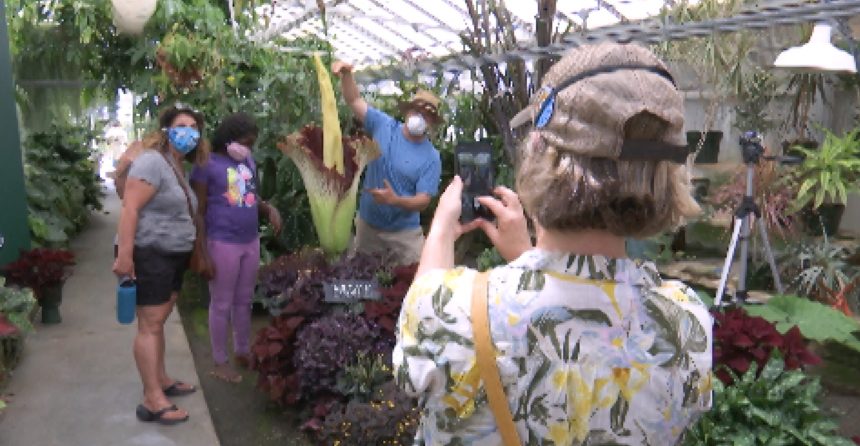“Corpse flower” blooms at Cal Poly, bringing hundreds of visitors to view the rare plant

SAN LUIS OBISPO, Calif. -- A rare "corpse flower" has bloomed at Cal Poly this week.
The plant known for its unpleasant aroma is now attracting hundreds of visitors to the university's plant shop.
"It doesn't happen too often, so everyone is excited," said Gage Willey, Cal Poly Plant Conservatory Manager. "This is the first-ever bloom we've had at Cal Poly, and so it's an historic bloom, which is why we're drawing such large crowds here at the horticulture unit."
On Friday, the line to view the flower wrapped around the building, with dozens of people waiting up to two hours for a one minute visit with the plant.
"The beauty of that plant is totally worth standing in line for," said Doris Lance of Paso Robles. "It's something that we never see common. The shape of it. The flowering of it. The color. It's just marvelous!"
Named Musty, like the school's mascot, the four-foot plant is an Amorphophallus titanum. It's been raised at the school for five years.
The famous plants are native to Sumatra in Southeast Asia and can grow to up to 10 feet tall.
According to Cal Poly growers, corpse flowers grow from a large underground stem and sends up one leaf a year. After 10 or more years, instead of making a leaf, the plant sends up a huge maroon funnel, called the spathe, with tiny flowers on a huge spike.
Willey said only a few dozen of the plants bloom each year, typically at universities or other institutions.
What makes the corpse flowers so well known and such a big draw is the infamous scent it produces
"They attract these nocturnal pollinators that are bees and flies attracted to rotting carcasses, and so it exudes this crazy aroma, this crazy chemical signature that it produces at the base of that flower to attract those pollinators at night. It opens up fully at night when it's producing the most stench," said Willey.
Since Musty bloomed this week, visitors have been patiently waiting to check the plant in person, some driving several hours to see it for themselves.
"It was neat," said Scott Klittich, who drove more than two hours from Fillmore with his wife. "The big funnel on it was neat. You could smell the odor, which was kind of like an old dead animal. I've smelled dead rats and dead squirrels and it was more like that. It's not attractive of course."
Others said the smell wasn't as bad as they had imagined.
"It had a smell, but it wasn't repugnant," said Lance. "It wasn't, like, I'm going to hold my breath until I walk through. It wasn't that bad."
"It was described to me as the smell of rotting flesh," said Kim Bisheff, a journalism instructor at the university. "I would say it's more like a sandwich shop at the end of the shift."
While most had a different description of the smell, everyone agreed that this was a pretty special occurrence that won't soon be forgotten, especially coming during these difficult times.
"It is amazing how much public support and interest we've had in a blooming flower," said Willey. "One single plant, and I think it's just wonderful for the community to have something to really come together about and have a shared love and and interest and it's bringing the community together."
"There's been so much negative news," said Bisheff. "It's hard to be in this world right now, and to see something like this, it's just pure positive and whimsy. It's an great opportunity. I wouldn't miss it."
The corpse flower blooms for only two days before it starts the next phase of its lifecycle.
"The very top will start to wither away and fall away, and the big skirt, that spath, will fall away and wither away, and you'll be left with a cluster of fruits sticking up out of the ground," said Willey.
With Musty now in its glory for only a few more hours, viewing concludes on Saturday.
The final viewing period at the Cal Poly Plant Shop is Saturday, July 11, from 9 a.m. to noon.
